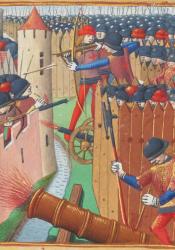European Artillery and the Hundred Years' War
Once the discovery of gunpowder was brought to Europe, it was quickly adopted and used for war. The Loshult Gun, also known as a hand cannon, is the earliest example of gunpowder-based European artillery, dating between 1330 and 1350. The cast bronze barrel would be ignited by a glowing iron placed directly on the gunpowder touch hole at the back of the gun and would fire projectiles such as rocks, iron bolts, or arrows. It is estimated that the Loshult Gun could successfully penetrate medieval armor and hit targets at about 200 meters. This technology would slowly evolve into an early prototype of the breech-loading cannon invented in the late 14th century.
These early firearms were first primarily used between the English and French during the Hundred Years' War (1337-1453), however they were not very effective. The cannons were hindered by a short range and limited mobility as well as ineffective projectiles. Despite their inability to inflict massive, devastating physical damage, they proved successful in delivering psychological damage. Similar to the Chinese's use of fireworks to scare their enemies, early cannons struck fear into their targets, making them a somewhat effective war tool. The Siege of Orleans in 1428 is a prime example of early cannon warfare. In combination with defenses such as scalding oil, hot coals, and rope nets, cannons proved effective in the defense of Orleans, killing a notable amount of soldiers.
Sources:
“Loshult Gun.” Wikimedia, Wikimedia Commons, 24 Nov. 2016, commons.wikimedia.org/wiki/File:Loshult_Gun.jpg.
“Gunpowder artillery in the Middle Ages.” Wikipedia, Wikimedia Foundation, 21 Feb. 2018, en.wikipedia.org/wiki/Gunpowder_artillery_in_the_Middle_Ages.
MD, Kurt Buzard. “Guns, Gunpowder and Longbows During the Hundred Years War.” Travel To Eat, 15 May 2014, traveltoeat.com/guns-gunpowder-and-longbows-during-the-hundred-years-war/.
Image Source: Bibliothèque nationale de France [Public domain], via Wikimedia Commons

